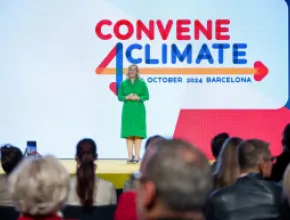We keep talking about how green meetings save money, but where is the proof? Today more than ever every decision must make financial sense. As an example of how green meeting practices play a role cutting costs, let’s take a look at a case study. To set the stage, this is a four-day technology conference with 1,000 participants using the convention center and three hotels. Not all of the items directly relate to environmental responsibility, but many do. (The cross-over items are in italics.)
The challenge: It’s January 2009, the economy is tanking, participants are not registering and the organization is committed to holding its annual conference. We needed to reduce costs below what was already contracted and have participants not notice the large cuts—get a terrific value for their conference dollars. The organization’s stakeholders realized the daunting task and made peace with the idea they are going to lose money because of the high fixed costs. Our mission is to minimize their loss.
Our promise: Thanks to our excellent relationships with all the vendors, we told the organization we would reduce their loss from nearly $300,000 to less than $30,000 several weeks before the conference. Diligent on-site at the conference, we awaited the final numbers.
The final results: Attendance for the 2009 annual conference was down 32 percent, but when the dust settled and the final numbers came in, we managed to save more than $350,000 on the items we controlled. In fact, the bottom line was…(drum roll, please)—a profit of more than $57,000!
Here’s how we managed to take this meeting out of the red and into the black:
We enrolled our vendor partners by having frank conversations to get every single person thinking of ways to cut costs. No idea was too crazy to consider! Every business we called did whatever they could to help us out:
- The CVB lowered room pickup minimums.
- The hotels kept room blocks open right up to the end and waived attrition.
- The convention center suggested ways to avoid room reset charges and kept labor costs down.
- The caterer and chef suggested alternative menus based on cost, including vegetarian options.
- The audiovisual company helped us select lower-tech/less-expensive items such as wired microphones rather than wireless lavaliere microphones (and threw in some freebies).
- The exhibit decorator minimized the use of meter boards and signage and helped eliminate everything extra possible. It’s important to note the decorator gave us discounts at the last minute to help.
- The promotional product supplier looked for the most environmentally responsible, cost-effective alternatives possible.
We also kept F&B as low as possible by utilizing these strategies:
- We reduced the “fancy” food--even at the board meeting they had a cold deli buffet lunch rather than a hot meal.
- We advised catering from the start that we would keep the food costs to the minimum required by contract.
We never served sodas, but instead substituted lemonade & iced tea, and water was served in bulk.Other cost-cutting strategies including the following:
- We reduced the quantity of signs produced by reusing the previous year’s signs over again (keeping the same basic logo each year without the current year identified).
- We eliminated some expensive give away items like USB keys. This was not a popular decision, but it saved the cost of the item, the cost of preloading the data and also the shipping costs. Instead, the presentation materials were kept very current on the conference website, so the participants could still get the information on-site and following the conference.
- We reduced the number of conference bags ordered: We asked the participants during registration if they wanted a conference bag, and told them we would give an extra drink ticket to those refusing bags—and surprisingly learned that more than 50 percent wanted a drink more than a bag.
- We eliminated sponsored items getting pre-stuffed in the bags, which saved on the shipping of the bags (50 percent fewer), on the cost of drayage with the decorator (lower poundage) and on the bag-stuffing labor costs. There were fewer exhibitor promotional materials shipped and less trash produced.
Besides all of the green items mentioned above, we also reduced labor by opening registration early on move-in day and encouraging delegates to register early, thereby reducing the initial first-day rush. By re-evaluating the registration processes we reduced registration labor by 30 percent. It worked perfectly; we never had more than three people in line at any given time
Today’s economy calls for working with your vendor partners and getting creative, and using green meeting practices can be a crucial cost-saving strategy. br>





